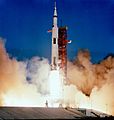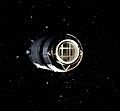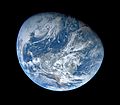Apollo 8 facts for kids
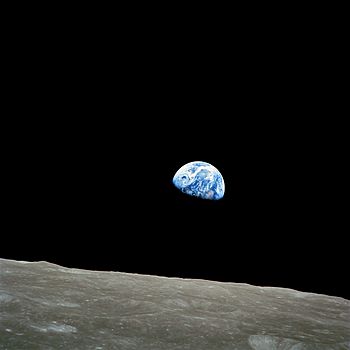
|
|
| Mission type | Crewed lunar orbiter |
|---|---|
| Operator | NASA |
| Mission duration | 6 days, 3 hours, 42 seconds |
| Spacecraft properties | |
| Spacecraft |
|
| Manufacturer | North American Rockwell |
| Launch mass |
|
| Landing mass | 4,979 kilograms (10,977 lb) |
| Crew | |
| Crew size | 3 |
| Members | |
| Callsign | Apollo 8 |
| Start of mission | |
| Launch date | December 21, 1968, 12:51:00 UTC |
| Rocket | Saturn V SA-503 |
| Launch site | Kennedy LC-39A |
| End of mission | |
| Recovered by | USS Yorktown |
| Landing date | December 27, 1968, 15:51:42 UTC |
| Landing site | North Pacific Ocean 8°8′N 165°1′W / 8.133°N 165.017°W |
| Orbital parameters | |
| Perigee | 184.40 kilometers (99.57 nmi) |
| Apogee | 185.18 kilometers (99.99 nmi) |
| Inclination | 32.15 degrees |
| Period | 88.19 minutes |
| Epoch | December 21, 1968, ~13:02 UTC |
| Revolution no. | 2 |
| Lunar orbiter | |
| Spacecraft component | CSM |
| Orbital insertion | December 24, 1968, 9:59:20 UTC |
| Orbital departure | December 25, 1968, 6:10:17 UTC |
| Orbits | 10 |
| Orbit parameters | |
| Periselene | 110.6 kilometers (59.7 nmi) |
| Aposelene | 112.4 kilometers (60.7 nmi) |
| Inclination | 12 degrees |
 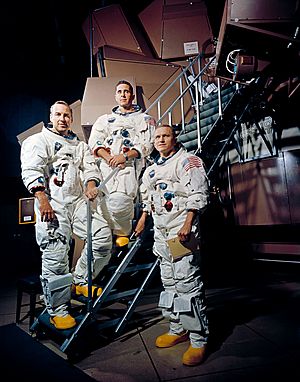 Left to right: Lovell, Anders, Borman |
|
Apollo 8 was a very important mission in the Apollo program in December 1968. It was the first time humans left Earth's orbit and traveled to the Moon. It was also the first time a crewed spacecraft orbited the Moon.
The three astronauts on this mission were Commander Frank Borman, Pilot Jim Lovell, and Bill Anders. They even broadcast a live television show from space! This was a huge deal because people on Earth could see what it was like near the Moon.
The Apollo Lunar Module, which was designed to land on the Moon, wasn't ready yet. So, the crew flew in the Apollo Command/Service Module. They spent twenty hours orbiting the Moon ten times. During this time, they took many pictures and studied the Moon from above. After their orbits, they fired their rockets to head back to Earth.
Contents
What was Apollo 8?
Apollo 8 was the second crewed mission in the Apollo program. Its main goal was to test how to fly to the Moon and orbit it. This mission was a big step towards landing humans on the Moon. It showed that NASA could send astronauts far beyond Earth.
Why was Apollo 8 so important?
- First trip to the Moon: It was the first time humans traveled all the way to the Moon.
- First to orbit the Moon: The spacecraft orbited the Moon ten times.
- First "Earthrise" photo: Astronaut Bill Anders took the famous "Earthrise" photo. This picture showed Earth rising above the Moon's horizon.
- Live TV from space: The crew broadcast live television from lunar orbit. This let millions of people on Earth see the Moon up close.
- Testing for future missions: Apollo 8 proved that the Saturn V rocket and the Apollo spacecraft could handle a trip to the Moon. This was vital for the later Apollo 11 Moon landing.
The Crew of Apollo 8
The three brave astronauts on Apollo 8 were chosen for their skills.
- Frank Borman was the mission commander. He was in charge of the flight.
- Jim Lovell was the Command Module Pilot. He later flew on Apollo 13.
- William Anders was the Lunar Module Pilot. Even though there was no Lunar Module on this flight, he helped with navigation and photography.
The Journey to the Moon
The Apollo 8 mission began on December 21, 1968. The powerful Saturn V rocket launched the spacecraft from Launch Complex 39A in Florida.
After leaving Earth's orbit, the spacecraft traveled for about three days. On December 24, 1968, Christmas Eve, Apollo 8 reached the Moon. The crew fired their engines to slow down and enter orbit around the Moon.
Orbiting the Moon
For twenty hours, the astronauts orbited the Moon. They saw the Moon's surface up close, including its many craters. They also saw the far side of the Moon, which is never visible from Earth.
During their tenth orbit, the crew read from the Book of Genesis. They shared this message with the world during their live TV broadcast. This moment was very moving for many people.
The Return to Earth
On December 25, 1968, the astronauts fired their engines again. This time, it was to speed up and leave the Moon's orbit. They began their journey back to Earth.
The trip back took another three days. On December 27, 1968, the Apollo 8 command module splashed down safely in the Pacific Ocean. The crew was picked up by the USS Yorktown aircraft carrier.
Related pages
Images for kids
-
The first stage of AS-503 being set up in the Vehicle Assembly Building (VAB) on February 1, 1968
-
Apollo 8 on top of the Saturn-V rocket being moved to Pad 39A
-
A part of the lunar far side as seen from Apollo 8
-
The command module on the deck of USS Yorktown
See also
 In Spanish: Apolo 8 para niños
In Spanish: Apolo 8 para niños







